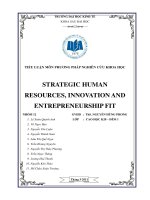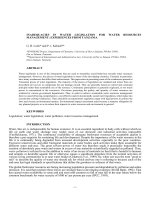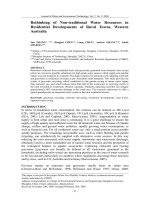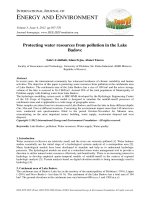080904 treasury mineral resources
Bạn đang xem bản rút gọn của tài liệu. Xem và tải ngay bản đầy đủ của tài liệu tại đây (317.45 KB, 45 trang )
Mineral and Petroleum Resources
Royalties Bill
September 2008
Contents
1
2
3
4
5
6
7
8
9
10
11
12
13
14
Background, MPRDA, Royalty Bill consultation process
Why mineral royalties – economic rationale
Refined and Unrefined minerals
Tax base: Gross Sales
Mineral royalty rates: Formulae
EBIT, with 100% capital expensing
Estimated mineral royalty rates
Rollover relief & Unincorporated bodies
Small business relief
Fiscal stability
Transitional measures
Administration
International examples
Mining Value Chain: Exploration, Mining, Mineral Processing,
Refining: First saleable point
2
Mineral and Petroleum Resources
Royalty Bill (B 59 – 2008)
1.
2.
3.
4.
5.
6.
7.
8.
9.
10.
11.
12.
13.
14.
15.
16.
17.
18.
Definitions
Imposition of royalty
Determination of royalty
Royalty formulae
Earnings before interest and taxes (EBIT)
Gross sales
Small business exemption
Exemption for sampling
Rollover relief for disposal involving going concerns
Transfer involving body of unincorporated persons
Arm’s length transactions
General anti-avoidance rule
Conclusion of fiscal stability agreements
Terms and conditions of fiscal stability agreements
Foreign currency
Transitional rules
Act binding on State and application of other laws
Short title and commencement
3
Ownership of Land and Minerals
•
•
•
•
•
Surface rights
Mineral rights
Land restitution and land reform
Indigenous communities
State
4
Background
•
•
•
•
•
•
•
•
•
•
•
•
Mineral and Petroleum Resources Royalty Bill (MPRRB) follows on the Mineral
and Petroleum Resources Development Act (MPRDA), (Act 28 of 2002)
1st draft Mineral and Petroleum Royalty Bill released for public comment on 20
March 2003
2nd draft of Royalty and Petroleum Resources Royalty Bill released for public
comment on 11 October 2006
May / June 2007 - Consultation, workshops
3rd draft of Royalty and Petroleum Resources Royalty Bill released for public
comment on 6 December 2007
4 March 2008 - Briefing by National Treasury to PCOF, 3rd draft
11 & 19 March 2008 - PCOF public hearings,
23 April 2008 – Consultation, workshop, preparation for 4th draft
13 May 2008 - PCOF briefing policy changes, basis for 4th draft
03 June 2008 - 4th draft published for technical comments only
17 June 2008 - PCOF briefing, 4th draft
24 June 2008 – Parliament, Minister of Finance - Introduction of Bill
5
Mineral and Petroleum Resources
Development Act (Act No. 28 of 2002)
(MPRDA)
The “MPRDA” provides for:
– All mineral rights to vest with the State
– Conversion of “old order” mineral rights into “new
order” rights by 1 May 2009
– Imposition of mineral royalties by the State:
Section 3 (2): As the custodian of the nation’s
mineral and petroleum resources, the State,
acting through the Minister may: (b) in
consultation with the Minister of Finance,
determine and levy, any fee or consideration
payable in terms of any relevant Act of
Parliament.
6
Mineral and Petroleum Resources
Development Act (Act No. 28 of 2002):
Community royalties
• The MPRDA Act reserves the right of communities to
receive a consideration or royalty.
• Item 11 of Schedule II of the Act states:
(1) Notwithstanding the provisions of item 7(7) and 7(8), any
existing consideration, contractual royalty, or future
consideration, including any compensation contemplated in
section 46(3) of the Minerals Act, which accrued to any
community immediately before this Act took effect, continues to
accrue to such community.”
(2) The community contemplated in (1) must annually, and at such
other time as required to do so by the Minister, furnish the
Minister with such particulars regarding the usage and
disbursement of the consideration or royalty as the Minister
may require.
7
Why mineral royalties (1)
“Although the structure and rates of mineral
royalties vary internationally, most are
collected for the same reason, that is
payment to the owner of the mineral resource
in return for the removal of the mineral from
the land. The royalty, as the instrument for
compensation, is payment in return for the
permission that, first, gives the mining
company access to the minerals and second,
gives the company the right to develop the
resource for its own benefit”. (James Otto, et al – The
World Bank, page 42)
8
Why mineral royalties (2)
“Another way in which a mine differs
from other businesses is that it exploits
a non-renewable resource that, in most
cases, the taxpayer does not own. In
the majority of nations, minerals are
owned by the state, by the people
generally, or by the crown or ruler”.
(James Otto, et al – The World Bank, page 16)
9
Tax base - mineral royalties
“Across the globe, no type of tax on
mining causes as much controversy as
a royalty tax. It is a tax that is unique to
the natural resources sector and on that
has manifested itself in a wide variety of
forms, sometimes based on measures
of profitability but commonly based on
the quantity of material produced or its
value”. (James Otto, et al – The World Bank, page 1)
10
Tax base = Gross Sales less
transport costs (clause 6)
• Gross Sales =
– Proceeds of a transferred mineral resource
at its readily saleable condition (i.e.,
refined or unrefined (“concentrate”) state
of mineral as specified)
– Disregard transportation costs of “final
product” (including insurance and handling
charges)
11
Refined and Unrefined minerals
(clause 1, and Schedules 1 and 2)
1.
Refined (Schedule 1):
•
•
•
•
•
•
2.
Gold; 99.5%
PGM – refined; 99.9%
Copper; 99.0%
Zinc; 98.5%,
Etc; &
Oil & Gas
Unrefined (Schedule 2):
•
•
•
•
•
•
•
•
•
•
•
•
Diamonds
PGM – concentrate
Iron ore; (between 61% to 64% Fe)
Coal – various grades
Manganese (between Mn37% to Mn48%)
Chrome (between 37% to 46% Cr2O3)
Mineral Sands
Zinc concentrate; 27% Zn
Uranium (80% concentrate)
Aggregates; Bulk
Etc.
Other; Concentrate or Bulk
12
Gross Sales - Refined: Schedule 1
(clause 6)
•
•
•
General Rule:
– Gross sales of refined minerals equal amounts received or
accrued (use spot rate if foreign currency is involved)
– However, an override exists to ensure that all transactions occur at
arm’s length
Different Condition:
– If a refined mineral is sold above the refined Schedule 1 condition,
(unlikely event) the gross sales price is reduced to a hypothetical
refined condition price
– If a refined mineral is sold below the refined Schedule 1 condition,
the gross sales price is increased to a hypothetical refined
condition price (or schedule 2 – unrefined formula)
Stolen, Destroyed or Lost:
– A deemed sales price applies at the proper condition so a royalty
is always charged even if no proceeds are obtained
– Rationale: Prevents evasion plus Government should not incur
the risk of a permanent loss (e.g. stolen) of a non-renewable
resource
13
Gross Sales – Unrefined: Schedule 2
(clause 6)
•
•
•
General Rule:
– Gross sales of unrefined minerals equal amounts received or
accrued (use spot rate if foreign currency is involved)
– However, an override exists to ensure that all transactions occur at
arm’s length
Different Condition:
– If an unrefined mineral is sold above the unrefined Schedule 2
condition, the gross sales price is reduced to a hypothetical refined
condition price
– If an unrefined mineral is sold below the unrefined Schedule 2
condition, the gross sales price is increased to a hypothetical
refined condition price
Stolen, Destroyed or Lost:
– A deemed sales price applies at the proper condition so a royalty
is always charged even if no proceeds are obtained
– Rationale: Prevents evasion plus Government should not incur
the risk of a permanent loss of a non-renewable resource
14
Dual Schedule Minerals
• Some minerals fall under both
schedules (e.g. platinum)
• In these circumstances, the mineral will
be viewed as refined if developed to or
above the refined condition; otherwise,
view as unrefined
• Example:
– Platinum 99,9% or above view as refined
– All other conditions view as unrefined
15
Tax rates – formula (clause 4)
(X = EBIT/Gross Sales *100)
1. Y (r) = 0.5 + X/12.5 (Max = 5.0)
Refined metal (e.g. refined Gold,
refined PGM, etc.), and Oil and Gas
2. Y (c) = 0.5 + X/9.0 (Max = 7.0)
Unrefined; Concentrate
Coal, Rough Diamonds, Iron Ore, etc.
16
EBIT: Basic Calculation (clause 5)
• EBIT = “taxable income” before interest and
taxes
• EBIT: Additions
– Gross sales (slides 13 and 14)
– Recoupment / recapture of depreciable mining
equipment
• EBIT: Subtractions
– All operating expenses
– All depreciation/CAPEX for machinery employed
to extract/upgrade/refine the mineral
• If EBIT < zero, assumed to be zero.
17
EBIT: Adjustments
(clause 5)
• No deductions for financial instruments (other than
hedges against mineral sales)
• No deduction for the royalty itself (to avoid
circularity)
• Transport between buyer/seller (and beyond the
refined/unrefined condition)
• No carryover of excess operating expenses (but
unredeemed mineral CAPEX can be carried over)
• Oil and gas also 100% write-off: deny additional
allowances in terms of the Tenth Schedule
18
Composite Minerals (clause 5)
• When an ore body contains a
combination of minerals
• General Rule: Allocate EBIT
deductions (refined versus unrefined)
according to a reasonable method
consistently applied
• De minimis: Less than 10% portions
can be viewed as the dominant portion
if desired (and if consistently applied)
19
Estimated Mineral Royalty Rates
Y = 0.5 + X/12.5 (Refined)
Y = 0.5 + X=/9 (Unrefined)
Profitability
EBIT/ Gross
Sales (%)
Refined
Min = 0.5
B = 12.5
Unrefined /
Concentrate
Min = 0.5
B=
9.0
0
0.5
0.5
10
1.3
1.6
15
1.7
2.2
20
2.1
2.7
25
2.5
3.3
30
2.9
3.8
40
3.7
4.9
50
4.5
6.1
56
5.0
6.7
58.5
5.2
7.0
70
6.1
8.3
20
Mining: R million: StatsSA,
P0044: 28 March 2008
1
Turnover received
2
2006
2007
203,467
291,737
Interest paid
5,398
6,794
3
Depreciation
15,358
19,667
4
Net profit before taxation
42,271
82,161
5
Total capital expenditure
36,090
33,777
6
Book value of assets
192,607
216,116
% Gross revenue:
7
Net profit before taxation
20.8%
28.2%
8
EBIT ( Depreciation )
23.4%
30.5%
9
EBIT ( Capital expensing )
13.2%
25.7%
EBITDA
31.0%
37.2%
10
21
Mining: R million: StatsSA,
P0044
Financial
ratios
Est. Royalty
Rates
2006
2006
Estimated Royalty Rates
Financial
ratios
2007
Rate
Est. Royalty
Rates
2007
Rate
Refined: Y = 0.5 +X/12.5
11
EBIT ( Depreciation )
23.43
2.37
30.5
2.94
12
EBIT ( Capital expensing )
13.24
1.56
25.7
2.55
Unrefined: Y = 0.5 = X/9.0
13
EBIT ( Depreciation )
23.43
3.10
30.5
3.9
14
EBIT ( Capital expensing )
13.24
1.97
25.7
3.4
22
Rollover relief and
Unincorporated Bodies (clauses 9 &10)
• Rollover Relief:
– If minerals are sold pursuant to the sale of a going concern
(e.g. the whole mining business or a severable part),
rollover relief applies
– If rollover relief applies, the transfer is ignored and the
transferee assumes the royalty liability upon subsequent
sale
• Unincorporated Bodies (e.g. Partnerships):
– An election can be made to tax the body (and not the
members on their proportionate share)
– The body is effectively viewed as a separate “extractor” with
the members being jointly and severally liable
23
Miscellaneous (clauses 7,8,12,13, &14)
• Small Business Relief:
– Relief applies if the royalty otherwise imposed does not
exceed R100 000 (and if gross sales do not exceed
R10.0 million)
– Rules against dividing-up big companies into small
businesses
• Sampling Relief:
– Exemption for sampling/testing (linked to section 20 of the
MPRDA)
– Up to R100 000 of gross sales
• General Anti-Avoidance Rule:
– Standard for most tax acts
• Fiscal Stability:
– Fixed parameters of formulae guaranteed
24
Transitional Rules
•
(clause 16)
Effective Date:
– Transfers occurring on or after 1 May 2009
– Applies even if parties only lodge for conversion as of 1 May 2009
(i.e. the royalty cannot be delayed further)
•
Transitional Credits:
– Previous consideration paid to the State for old order rights (State
Lease Payments) to be offset (i.e. a credit) against the royalty
– Might be of importance in the case of minerals won/recovered
before 1 May 2009 (and State lease paid) and transferred
afterwards
– Also important for parties that only have lodgings but not yet
converted on 1 May 2008 (and hence both State Lease Payments
and new Royalties are due)
– No credit for certain profit sharing arrangements (i.e. Diamonds)
and considerations to communities
25









